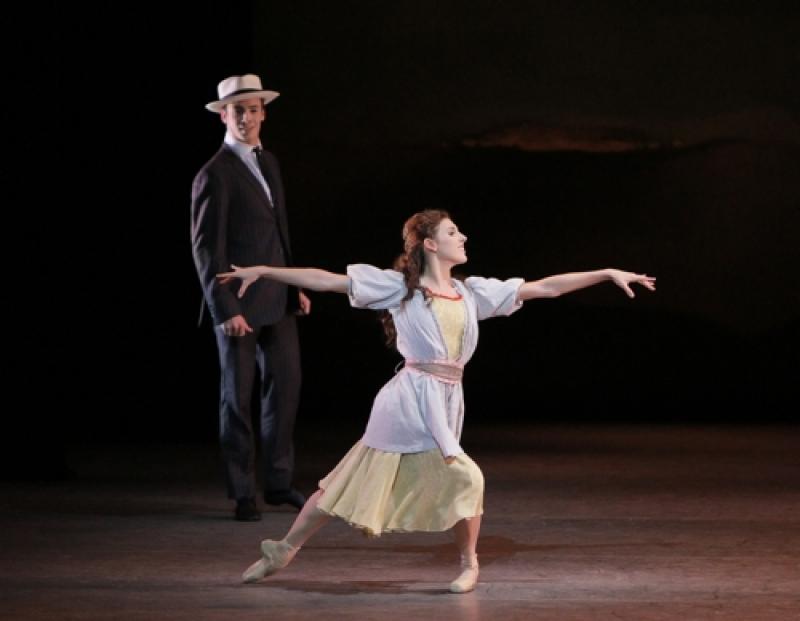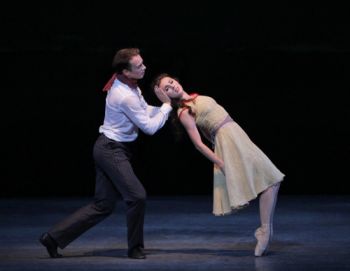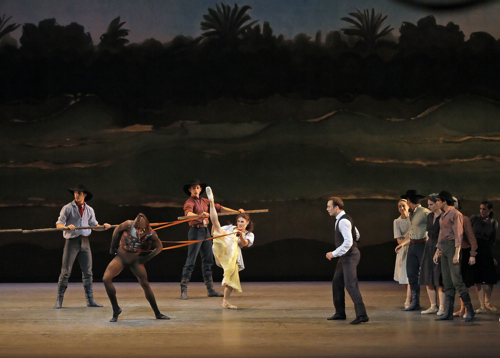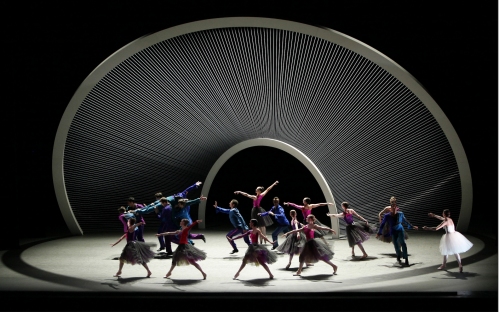Christopher Wheeldon premiere, New York City Ballet | reviews, news & interviews
Christopher Wheeldon premiere, New York City Ballet
Christopher Wheeldon premiere, New York City Ballet
Story-ballets are back with a vengeance at the temple of abstract ballet

What is going on at New York City Ballet, home of the abstract, neo-classical, pared-down, no-scenery, no-story, nothing-extraneous aesthetic that George Balanchine made into an artistic religion? So far, three out of the four pieces commissioned for the company’s ambitious “Architecture of Dance” festival have been - more or less - story ballets (only Wayne McGregor has resisted the lure).
Estancia has an interesting history; the score was commissioned in 1941 by Lincoln Kirstein, during a South American tour by the New York City Ballet’s precursor, the American Ballet Caravan. Kirstein intended Balanchine to choreograph the ballet, but Ballet Caravan disbanded that year, and the piece was never made in the US. (The score was used in 1952 by Michael Borowski, who choreographed the ballet for the Teatro Colon in Buenos Aires.) This history makes a nice neat loop back to City Ballet, and it’s easy to see (or hear) the appeal of the score, full of dancey folk rhythms and lyrical romanticism. What is surprising is how literally Wheeldon has used the original libretto, which sets the action on an estancia, or ranch in the Argentinian Pampas.
 A city boy (Tyler Angle), in suit and hat, arrives early one morning to find a group of country folk beginning their daily tasks. He is immediately drawn to a local girl (Tiler Peck), who rejects him, but is eventually won over when he tames one of the wild horses that the ranchers are trying to subdue. Love blooms, and a pas de deux follows as night must day. (In fact, night does follow, then day again - the action takes place in a 24-hour span that is beautifully suggested by Mark Stanley’s marvellous lighting.)
A city boy (Tyler Angle), in suit and hat, arrives early one morning to find a group of country folk beginning their daily tasks. He is immediately drawn to a local girl (Tiler Peck), who rejects him, but is eventually won over when he tames one of the wild horses that the ranchers are trying to subdue. Love blooms, and a pas de deux follows as night must day. (In fact, night does follow, then day again - the action takes place in a 24-hour span that is beautifully suggested by Mark Stanley’s marvellous lighting.)
Wheeldon does an admirable job with all of this. The opening solo for Angle, against a beautiful painted backdrop by the architect Santiago Calatrava (who has done the scenic design for four of the seven festival ballets) which evokes the wide plains of the pampas, is langorously lyrical and moody; Peck’s character is quickly established as his counterpart through a melancholy solo of her own, set against slow-moving groups of the country people.
There are strong overtones of Agnes de Mille’s Rodeo and even Martha Graham’s Appalachian Spring in these images - the lone woman or man against the vast plains, the idea of the essential nature of country life, the choreographic suggestions of rootedness in the earth as groups bend into deep second-position pliés or stoop to the ground with repetitive sowing motions.
Later, Wheeldon changes the tone and the pace with the slightly fantastical introduction of five dancers as wild horses - a potentially disastrous idea that actually works rather well once you suspend disbelief about animals on pointe. The unexpected effectiveness of the horse section is partly due to the strangely realistic effect of Carlos Campos’s bodystocking costumes, partly to Wheeldon’s mane-tossing, tail swishing choreography, danced with fierce bucking, leaping energy, most particularly by Andrew Veyette and the marvelous Georgina Pazcoguin.

Angle eventually tames Pazcoguin, catching her in a Firebird-style foot-to-back-of-head attitude, and Peck is his. Night falls, the stars emerge, and the pair dance a beautifully tender pas de deux, devoid of impressive lifts and tricky partnering, full of slow turns and small bends and tilts in and out of supported positions, suggesting their mutual dependence, a literal falling-in-love. Here, as in the rest of the ballet and its rousing finale, Wheeldon does an impeccable job of conveying his story through the movement. His deployment of groups, his structural composition are things of beauty.
He makes lovely use of a sung interlude (a fine performance from Philip Cutlip) by setting Angle and Peck in a side-by-side dreamy duet. And he gives his central couple roles that bring out unexpected aspects of their dancing. Peck, a technical whizz who is often cast in soubrette roles, shows a dramatic, earthier self; Angle, a long-limbed natural ballet prince, is softer and funnier, uninhibited and touching.
But in taking on a story ballet, Wheeldon doesn’t resist the tropes of the genre, and they crop up with annoying and predictable regularity. No couple-to-be in a ballet ever meet without a locked-eyes, frozen moment of recognition before the inevitable rejection. No feisty female lead ever does anything but melt unhesitatingly into the man’s arms the minute the rejection period is over. No outsider is ever looked upon with anything but suspicion by the crowd. No hero is ever accepted into that crowd without first getting slightly manhandled, then given an approving slap on the back. And so on.
It’s hard also not to see the literalism of Estancia as a strange throwback to another era, no matter how well done. But perhaps I’m alone in this opinion; the audience clearly adored the ballet, giving the dancers and Wheeldon a long standing ovation, and the most enthusiastic response of any of the festival premieres so far.
Below, Gustave Dudamel conducts the Simon Bolivar Youth Orchestra in dances from Ginastera's 'Estancia' (YouTube):
Millepied’s why am I etc, (surely the worst title of the year? the decade? ever?), which had its official premiere last week after a preview outing at the company gala, took a more cautious approach to narrative. With clear echoes of Balanchine’s La Valse, and fainter ones of Prodigal Son, it sets an outsider (Sean Suozzi), dressed in white, amidst a crowd of dancers in particularly ugly ballroom-style costumes (by Marc Happel) of turquoise, purple, green and pink. Suozzi is drawn to one of the young girls (Kathryn Morgan), but apparently invisible to her and the others until the evil masterminds of the piece, Amar Ramasar and Sara Mearns, begin to layer brightly coloured garments upon him. Now Morgan can see him, and return his affections, but for some inexplicable reason, the evil pair intervene, pulling off the outer layer of her costume so that now she is dressed in white and invisible to him.
Millepied creates a big, ambitious ballet out of all of this, its scale amplified by Calatrava’s huge, sculptural semicircle-within-a-semicircle that covers the back of the stage and provides a central entranceway for the dancers. The sculpture is rather beautiful, the cords between the two curves shimmering and changing colour in the light, but Millepied doesn’t do much with it, apart from letting us glimpse Mearns and Ramasar plotting behind. (Below, the ensemble photographed by Paul Kolnik)
The music, a commissioned score by Thierry Escaich, is full of shimmering tones, and soft percussive sounds that sometimes recall Stravinsky’s Firebird, and Millepied uses it skillfully, creating big swoops of corps de ballet movement, impassioned pas de deux, and dramatic solos for Mearns and Ramasar. But despite committed performances by the principals, there is something generic-feeling and implausible (even with the general implausibility of the genre) about the whole ballet. You never understand why Suozzi is rushing around moodily, or why Morgan is any different from any of the other girls at the ball, or why Ramasar and Mearns have to incarnate von Rothbart and Cruella de Ville (which they do with admirable energy).
As efficient as Millepied’s choreography is, the movement never communicates character, intention or emotion as it does in Estancia. Both ballets seem oddly old-fashioned works to produce in 2010, but Wheeldon at least captures something genuine in his story and his characters. Millepied, a strangely on-and-off choreographer, doesn’t yet seem to have found a real voice. You get the feeling, looking at his work for different companies, that he is something of a chameleon, trying to meet expectations rather than following an inner voice. He is a skillful enough craftsman to make us hope he can find it.

- Christopher Wheeldon's Estancia is performed again at New York City Ballet on 1, 4, 6 & 11 June. Millepied's why am I... is performed again on 3 June
- Find Ginastera's Estancia on Amazon
- Photographer Paul Kolnik's website
Explore topics
Share this article
The future of Arts Journalism
You can stop theartsdesk.com closing!
We urgently need financing to survive. Our fundraising drive has thus far raised £49,000 but we need to reach £100,000 or we will be forced to close. Please contribute here: https://gofund.me/c3f6033d
And if you can forward this information to anyone who might assist, we’d be grateful.

Subscribe to theartsdesk.com
Thank you for continuing to read our work on theartsdesk.com. For unlimited access to every article in its entirety, including our archive of more than 15,000 pieces, we're asking for £5 per month or £40 per year. We feel it's a very good deal, and hope you do too.
To take a subscription now simply click here.
And if you're looking for that extra gift for a friend or family member, why not treat them to a theartsdesk.com gift subscription?
more Dance
 'We are bowled over!' Thank you for your messages of love and support
Much-appreciated words of commendation from readers and the cultural community
'We are bowled over!' Thank you for your messages of love and support
Much-appreciated words of commendation from readers and the cultural community
 Peaky Blinders: The Redemption of Thomas Shelby, Rambert, Sadler's Wells review - exciting dancing, if you can see it
Six TV series reduced to 100 minutes' dance time doesn't quite compute
Peaky Blinders: The Redemption of Thomas Shelby, Rambert, Sadler's Wells review - exciting dancing, if you can see it
Six TV series reduced to 100 minutes' dance time doesn't quite compute
 Giselle, National Ballet of Japan review - return of a classic, refreshed and impeccably danced
First visit by Miyako Yoshida's company leaves you wanting more
Giselle, National Ballet of Japan review - return of a classic, refreshed and impeccably danced
First visit by Miyako Yoshida's company leaves you wanting more
 Quadrophenia, Sadler's Wells review - missed opportunity to give new stage life to a Who classic
The brilliant cast need a tighter score and a stronger narrative
Quadrophenia, Sadler's Wells review - missed opportunity to give new stage life to a Who classic
The brilliant cast need a tighter score and a stronger narrative
 The Midnight Bell, Sadler's Wells review - a first reprise for one of Matthew Bourne's most compelling shows to date
The after-hours lives of the sad and lonely are drawn with compassion, originality and skill
The Midnight Bell, Sadler's Wells review - a first reprise for one of Matthew Bourne's most compelling shows to date
The after-hours lives of the sad and lonely are drawn with compassion, originality and skill
 Ballet to Broadway: Wheeldon Works, Royal Ballet review - the impressive range and reach of Christopher Wheeldon's craft
The title says it: as dancemaker, as creative magnet, the man clearly works his socks off
Ballet to Broadway: Wheeldon Works, Royal Ballet review - the impressive range and reach of Christopher Wheeldon's craft
The title says it: as dancemaker, as creative magnet, the man clearly works his socks off
 The Forsythe Programme, English National Ballet review - brains, beauty and bravura
Once again the veteran choreographer and maverick William Forsythe raises ENB's game
The Forsythe Programme, English National Ballet review - brains, beauty and bravura
Once again the veteran choreographer and maverick William Forsythe raises ENB's game
 Sad Book, Hackney Empire review - What we feel, what we show, and the many ways we deal with sadness
A book about navigating grief feeds into unusual and compelling dance theatre
Sad Book, Hackney Empire review - What we feel, what we show, and the many ways we deal with sadness
A book about navigating grief feeds into unusual and compelling dance theatre
 Balanchine: Three Signature Works, Royal Ballet review - exuberant, joyful, exhilarating
A triumphant triple bill
Balanchine: Three Signature Works, Royal Ballet review - exuberant, joyful, exhilarating
A triumphant triple bill
 Romeo and Juliet, Royal Ballet review - Shakespeare without the words, with music to die for
Kenneth MacMillan's first and best-loved masterpiece turns 60
Romeo and Juliet, Royal Ballet review - Shakespeare without the words, with music to die for
Kenneth MacMillan's first and best-loved masterpiece turns 60
 Help to give theartsdesk a future!
Support our GoFundMe appeal
Help to give theartsdesk a future!
Support our GoFundMe appeal

Add comment